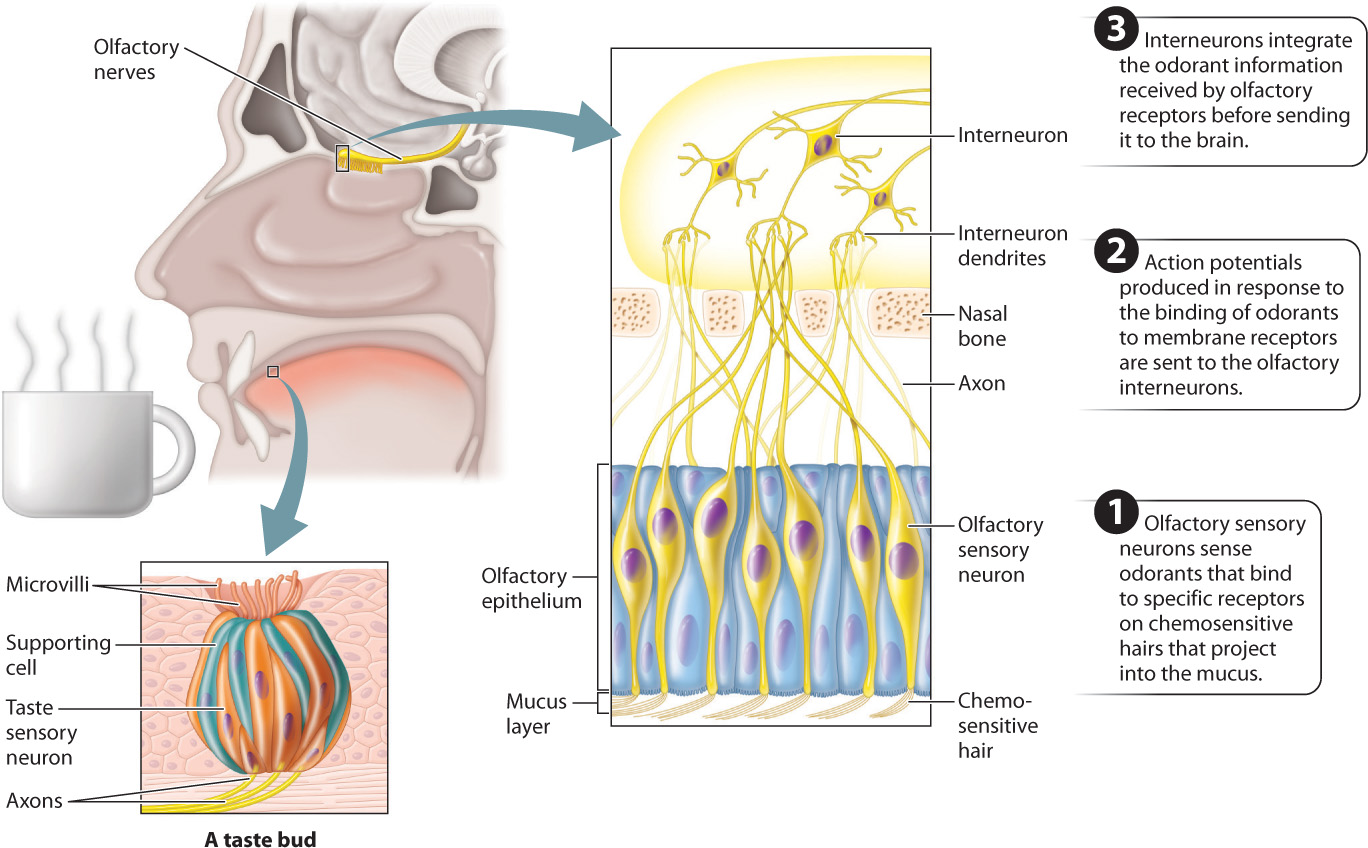36.2 SMELL AND TASTE
In many animals, specialized sensory organs for smell (olfaction) and taste (gustation) have evolved that detect a variety of chemical compounds. These organs contain distinct types of protein membrane receptor, and each of them binds to a specific class of molecule of complementary chemical structure. A large number of genes code for different chemical odor receptors, and the presence of so many receptors enables the detection of broad categories of smell and taste.
36.2.1 Smell and taste depend on chemoreception of molecules carried in the environment and in food.
The sense of smell in mammals depends on specialized sensory neurons that extend into the nasal cavity. These neurons communicate directly with the brain by the olfactory nerve, one of the cranial nerves of the head (Fig. 36.5). Odor molecules are captured by nasal mucus during inhalation and sensed by the cells’ long, thin hairlike extensions, which project into the mucus. Membrane receptors on these extensions bind odor molecules that are complementary in structure to the receptor. When bound, the odor molecules produce excitatory postsynaptic potentials (EPSPs). If enough odor molecules bind to the receptor cell, the EPSPs are summed and transmit an action potential to the brain.

Each sensory receptor has one type of membrane receptor, but there are typically many different sensory receptors for many different molecules. Humans have nearly 1000 genes that express particular odorant receptor proteins. Mice have about 1500 genes that express odorant receptor proteins, constituting about 15% of all their genes. The olfactory system can detect specific odor molecules in quite low concentrations.
Taste, or gustation, is achieved by clusters of chemosensory receptor cells located in specialized taste buds, the sensory organs for taste (Fig. 36.5). Some fish have taste buds in their skin that sense amino acids in the water, helping them to localize food. The taste buds of terrestrial vertebrates are in the mouth; most of the taste buds in mammals are on the tongue. In humans, the tongue has about 10,000 taste buds, which are contained within raised structures called papillae, giving the tongue its rough surface. Each taste bud has a pore through which extend fingerlike projections of sensory cells called microvilli that contact food items. The microvilli provide a large surface area that is rich in membrane receptors. These receptors bind to specific chemical compounds that give the food its taste. Taste bud sensory cells synapse on interneurons, which fire action potentials when a sufficient number of sensory cells are depolarized by a particular food item. In contrast to olfaction, taste generally requires higher concentrations of food chemicals coming into contact with taste bud receptors to stimulate receptor depolarization.
Human taste can be divided into five categories—sweet, sour, bitter, salty, and savory. The tongue contains only five types of taste receptor, one specialized for each of these categories. Variation in taste is achieved by combining the signals received by receptors in the five categories. Your sense of taste is substantially enhanced by airborne odors that emanate from a food or beverage and are sensed by chemoreceptors in the nose. Signals from taste bud and olfactory receptors are combined in the brain, eliciting the subtle sensation of taste and flavor of a particular food or drink.
Quick Check 2
Why is your sense of smell and taste diminished when you have a cold?